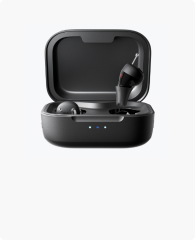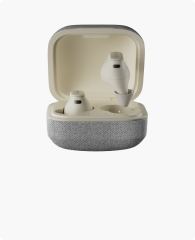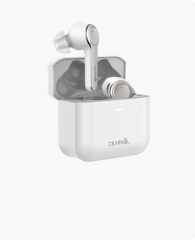Do you have small ear canals? Then finding the right hearing aid can be challenging. Standard designs are often uncomfortable and slip out easily. That's why hearing aids for small ear canals should be compact and custom-fitted for maximum comfort and clarity. In this guide, we will explore why people with small ear canals need specialized hearing aids, reveal the best models and top OTC options, share expert buying tips, and introduce a standout device you won't want to miss.
🚀 Navigate This Post
You may also be interested in:
- Best Cheap Hearing Aids on Amazon in 2025
- Best Hearing Aids to Reduce Background Noise for Seniors
- [New] Best Affordable Hearing Aids with Bluetooth in 2025
Part 1: Why Small Ear Canals Need Special Hearing Aids?
If you have small ear canals, it can be difficult to find comfortable and effective hearing aids. Here are the main reasons why you need specialized hearing aids:
1. Poor Fit with Standard Models
Regular aids can feel too bulky, causing irritation or frequent adjustments. Compact options like Invisible-in-Canal (IIC), ITE hearing aids, and Completely-in-Canal (CIC) styles can ensure a snug, natural fit.
2. Risk of Acoustic Feedback
Without a secure seal, sound may leak and create whistling. Here, Receiver-in-Canal (RIC) models can be an ideal choice, which is designed for narrow canals because it sits deeper in the ear.

3. All-Day Comfort
Smaller canals are prone to more wax and moisture, which can clog large devices. Specialized aids use breathable materials and tiny components to reduce buildup and irritation.
4. Better Sound Quality
Deeper placement within the canal enhances sound clarity by using your ear's natural shape to improve amplification.
5. Discreet Appearance
Those with small ears often prefer nearly invisible options. Compact designs combine strong performance with subtle looks, making them perfect for everyday confidence.
Part 2: How to Choose the Right Hearing Aids for Small Ears?
Now you know the reasons to use specialized hearing aids for small ears. The next step is to choose the right one. Here are the key factors to consider.
1. Style and Size
Choose Invisible-in-Canal (IIC), Completely-in-Canal (CIC), In-the-Ear (ITE), or slim Receiver-in-Canal (RIC) models. These styles sit in the ear/ canal and offer a nearly invisible, natural look while maintaining comfort.
Avoid bulky Behind-the-Ear (BTE) models unless they are customized with mini earmolds to ensure a secure, lightweight fit. Look for low-profile, ergonomic designs that balance discreet appearance with strong sound performance.
ite-hearing-aids-for-small-canals
2. Custom Fit or OTC
Custom hearing aids often provide the most secure seal and precise fit, but they require a professional audiologist for molding and adjustments. OTC models are more convenient and affordable. You can look for options with adjustable ear domes or self-fitting guides to tailor the fit for small ear canals.
3. Battery Life and Charging
Compact hearing aids have smaller batteries, and rechargeable models with long runtimes are ideal. You should also choose devices that offer all-day use on a single charge with a portable charging case. This provides added convenience and recharging on the go.
4. Noise Reduction and Sound Features
Prioritize aids with adaptive listening modes that automatically adjust in noisy or quiet environments. Effective noise cancellation and feedback suppression help maintain clear, comfortable sound.
5. Price and Accessibility
For OTC options, look for products that offer risk-free trials and read user reviews focused on fit, comfort, and real-world performance. So you can make sure you get the right device for your ear size and lifestyle.
Part 3: Cearvol's Best OTC Hearing Aids for Small Ear Canals
When it comes to the best hearing aids for small ear canals, the Cearvol Nano stands out as a top-tier choice. Priced at $299 (on sale from $349), this In-the-Ear (ITE) model combines a discreet appearance with remarkable comfort. If you are looking for an OTC hearing aid for small canals, Cearvol Nano is an excellent solution.
Here are what make it the best OTC hearing aids for small ear canals.
1. Up to 30dB Gain
Cearvol Nano Nano delivers up to 30dB of gain(3 levels), offering clear and balanced sound amplification for users with mild to moderate hearing loss.
2. Adaptive Listening Modes
It provides adaptive settings to fine-tune your hearing for comfort and clarity. You can switch to Restaurant Mode to cut background chatter, Outdoor Mode to reduce wind and traffic noise, and Indoor Mode for everyday environments.
3. Long Battery Life and Smart Charging Case
Get up to 16 hours of continuous use per charge, with the portable charging case extending total usage to 54 hours. It's the best Hearing aids for small ear canals that are compact enough for travel yet durable for daily use.
4. Built-in UV Sterilization
The Nano Starlight's smart case includes UV sterilization technology that eliminates 99.9% of bacteria and germs with every charge, keeping your hearing aids clean and safe for sensitive ear canals.
5. User-Friendly Controls
There is no need for complicated apps or tiny buttons. Adjust volume and modes directly through the smart case. The intuitive design is just great for first-time users and seniors.
Part 4: Tips for Seniors with Small Ear Canals to Get the Best Experience
If you are a senior with smaller ear canals and need to enhance comfort and sound performance, here are a few tips to get the most out of your device:
1. Ensure a Secure, Comfortable Fit
It's recommended to have your ear canals professionally measured before choosing a device. If you go with OTC hearing aids, use adjustable ear tips or domes for a gentle seal first. Practice careful insertion to avoid irritation; you can use a mirror to help until it feels better.
2. Keep a Consistent Cleaning Routine
After daily use, wipe your aids with a soft, dry cloth to remove oils, wax, and debris. You might also need to deep-clean it from time to time. For a full guide, check out how to clean hearing aids safely and effectively.

3. Manage Moisture and Humidity
Moisture can quickly affect performance in smaller devices. Use a drying kit or dehumidifier each night to prevent condensation or wax buildup.
4. Inspect Regularly and Replace Filters
Check for wax accumulation weekly, and replace wax filters every month. Seniors should also consider professional cleanings every six months to maintain peak sound quality.
5. Adopt Smart Daily Habits
Avoid wearing aids during showers or when swimming. For active seniors, test your hearing aids during walks, exercise, or group events to ensure they remain secure and deliver clear sound in motion.









Leave a comment
All comments are moderated before being published.
This site is protected by hCaptcha and the hCaptcha Privacy Policy and Terms of Service apply.